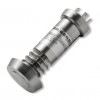I have a 3.5 Mtr dia, 10 mtr height milk tank, How do I convert the pressure reading to quantity of milk at bottom temperature which varies approx 10 deg C to 4 deg C, please suggest how to calculate the level and volume of milk?
First you will need to determine the density of the Milk at different temperatures, if you do not know this, then you can use this guide to the physical properties of milk.
To improve the accuracy of your readings you can also use local gravity instead of standard gravity (9.80665 m/s2). If you do not know your local gravity then use this tool which calculates local gravity from latitude.
Once you know the density (SG) and the local gravity you can use this tool to convert the pressure reading into liquid level.
To determine the volume of milk in the tank use this vertical cylindrical tank contents calculator.
Example Calculation
- Specific Gravity → So in your example the SG of milk at 10°C would be 1.033.
- Gravity → If the location was New Delhi which has a latitude of 28.613333 and an elevation of 216 metres, the gravity would be 9.79151 ms-2.
- Level → A 500 mbar pressure reading would represent a milk level of 4.9433 metres.
- Volume → A 4.9433 metre level of milk would represent a volume of 47560 litres.
Related Help Guides
- Measuring the volume of liquid in a horizontal cylinder tank
- Determining water tank volume using hydrostatic pressure
- How do you measure the volume of a liquid using pressure
- Determining the hydrostatic pressure range for a tank level sensor
Related Technical Terms
Related Online Tools
- Distance Travelled & Fuel Volume Used to Fuel Economy Calculator
- Fuel Volume Used & Distance Travelled to Motor Vehicle Fuel Consumption Calculator
- Density Converter
- Vehicle Fuel Economy Converter
- Vehicle Fuel Consumption Converter
- Vertical Cylindrical Shaped Tank Contents Calculator
- Horizontal Cylindrical Shaped Tank Contents Calculator
- Rectangular Shaped Tank Contents Calculator
- Length, Width & Height to Volume Calculator
- Vehicle Fuel Economy to Consumption Calculator
- Vehicle Fuel Consumption to Economy Calculator


